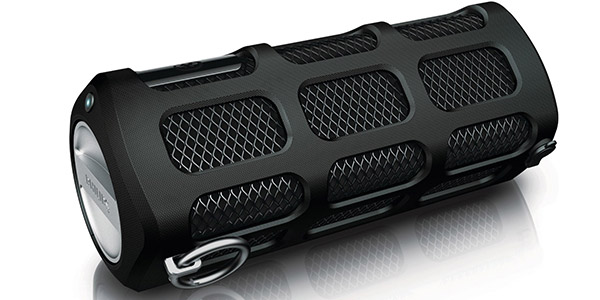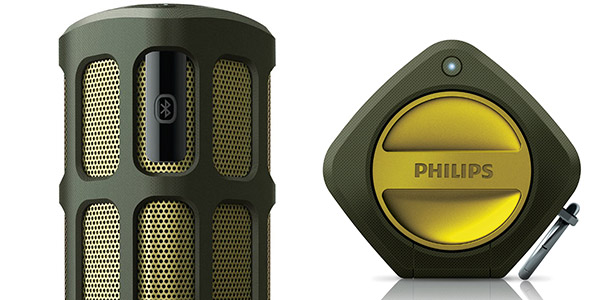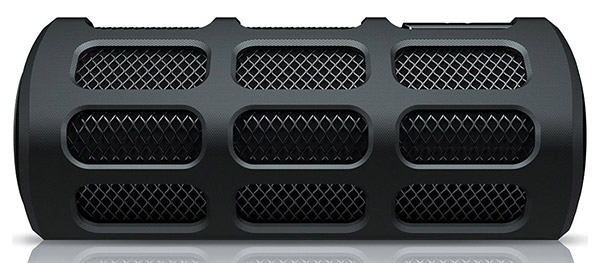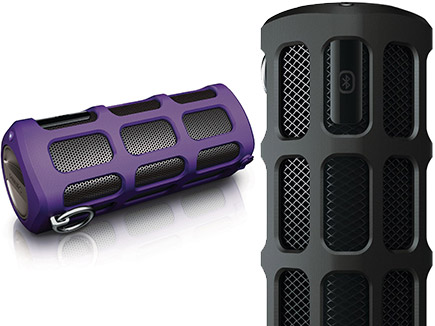Tom's Guide Verdict
The Shoqbox 7200 is packed with more features than most Bluetooth speakers in this price range, but the sound just isn't good enough.
Pros
- +
Clear speakerphone
- +
Can connect two speakers for wider sound field
- +
Inexpensive
Cons
- -
Weak bass and thin treble tones
- -
Limited battery life
- -
Finicky motion sensor
Why you can trust Tom's Guide
In most cases, if you want a full-featured portable Bluetooth speaker — one with a speakerphone and ruggedness in addition to wireless music playback — you'll need to spend about $200. But the Philips Shoqbox 7200 packs in those features and costs just $150 (or less, if you shop around). But based on our testing, the Shoqbox isn't as much of a bargain as it sounds.
Design

The Shoqbox 7200 looks as tough as its name implies; it's encased in a hard-plastic grille that protects the two 1-inch drivers. Philips opted for a pentagonal shape (7 x 2.8 x 2.7 inches), which helps to provide some stability when you set it down. The grille is wrapped with a second protective layer made from softer rubber to further help keep it from harm.
Even with all that armor surrounding the unit, the speaker still felt light in our hands. At 17 ounces, the Shoqbox weighs a few ounces less than the 7.1 x 2.6-inchUE Boom's 19 ounces, and weighs the same as the 7.4 x 2.9 x 2.3-inch Fugoo Style.
On one end of the speaker are a small power button and a large knob that controls the master volume. Turning this knob doesn't control the volume on the audio source; you adjust the speaker volume and the audio source volume independently. We recommend starting with both at half and adjusting it according to your environment and volume tolerance.
The speaker lacks visual cues and instead uses voice feedback to indicate battery life, connection status and other details, similar to on the Fugoo and Jabra Solemate. The voice guidance can be turned down using the speaker volume control — a nice touch that other speakers lack.
MORE: Best Bluetooth Speakers
Gesture Control
One thing that distinguishes the Shoqbox from other Bluetooth speakers is its motion sensor, which allows you to control playback without touching your mobile device or computer. Swipe forward to skip to the next song, and swipe back to rewind. Motion down to pause, and motion up to play again.
While the idea seems great on a spec sheet, we found the execution to be spotty. We had trouble getting the sensor to work when we wanted it to, and it often reacted to our incidental movements when we weren't intending to pause a song or skip to the next track.
Weatherproofing
The Shoqbox 7200 is designed to take a licking and keep on ticking. The speaker is drop resistant and IPX 4 weather-resistance rated, meaning it can withstand a splash of water, but shouldn't be dunked. That's the same rating as the UE Boom, but well below the Fugoo's 67 IPX rating, which allows you to dunk it underwater for up to 30 minutes.
Setup and Use

The Shoqbox paired quickly with iOS and Android devices over Bluetooth. When not paired with a nearby device, the speaker goes into discovery mode when you turn it on. On an Android device, you just have to go to Settings and look for the speaker listed in Available Devices. In iOS, go to Settings > Bluetooth, where the Shoqbox 7200 Series should appear under Devices.
We found that the Shoqbox maintained a Bluetooth connection at 30 feet without a problem, as long as there were no walls in the way. Outdoors, the connection also remained strong with a clear line of sight.
The Shoqbox features a 3.5mm auxiliary input, which allows you to connect it directly to your device's headphone jack. This option is good if you don't have Bluetooth or want to conserve battery power.
Audio Performance
The Shoqbox is big on features, but not on sound quality. It focuses on midranges, where most singing lives. Beck's multilayered vocals on "Heart Is a Drum" sounded full, while Lorde's lyrics on "Team" came through loud and clear. But as we listened closely, we found that the songs lacked the oomph of low-end frequencies and the crisp tones of the upper end.
This was especially evident on St. Vincent's "Digital Witness" — the Shoqbox left out the deep bass line completely. The saxophones on Charles Mingus' "Goodbye Pork Pie Hat" sounded thin and veiled, unlike the warmth portrayed by better portable Bluetooth speakers such as the Fugoo.
You can pair two Shoqbox speakers together to help improve the audio performance. We weren't able to test this with the Shoqbox, but for similar portable Bluetooth speakers, this has proven to be a handy extra feature.
Speakerphone
Thanks to its strength in midrange tones, the Shoqbox produced clear voices during speakerphone calls. Philips doesn't include Siri or Google Now integration, so you can't use voice commands to initiate or end calls — a feature we've seen on slightly more expensive units like the Fugoo and the Klipsch Gig.
MORE: Top Smartphones On The Market Now
Battery Life
The Shoqbox has fairly limited battery-life expectations compared to similarly priced Bluetooth speakers. Philips says you can get 8 hours of playback on a full charge. After a few hours of listening, we noticed the battery-life indicator was already down to half. The only portable Bluetooth speaker that we've tested with a shorter battery life is the JBL Pulse, which includes a light show. The best speaker in this class, the Fugoo, offers 40 hours of rated playback when fully charged.
Verdict

With compelling features — such as a clear speakerphone, weatherproofing and motion control — the Philips Shoqbox 7200 can be seen as a deal for $150 or less. But we recommend spending the extra money for the Fugoo Style or UE Boom, which offer much better audio quality and battery life for less than $200.
Follow Michael Gowan @zebgowan and on Google+. Follow us @tomsguide, on Facebook and on Google+.

Michael Gowan is a freelance technology journalist covering soundbars, TVs, and wireless speakers of all kinds of shapes and sizes for Tom’s Guide. He has written hundreds of product reviews, focusing on sound quality and value to help shoppers make informed buying decisions. Micheal has written about music and consumer technology for more than 25 years. His work has appeared in publications including CNN, Wired, Men’s Journal, PC World and Macworld. When Michael’s not reviewing speakers, he’s probably listening to one anyway.

